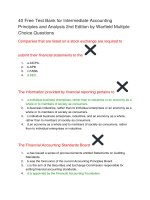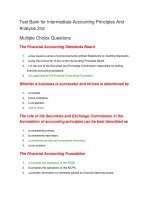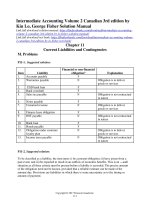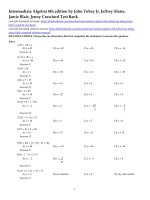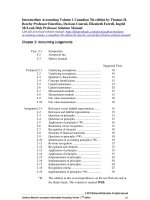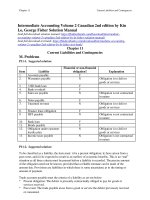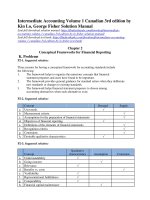Intermediate accounting principles and analysis 2nd edition by warfield weygandt and kieso test bank
Bạn đang xem bản rút gọn của tài liệu. Xem và tải ngay bản đầy đủ của tài liệu tại đây (585.92 KB, 29 trang )
Test bank for Intermediate Accounting Principles and Analysis 2nd
Edition by Terry D.Warfield ,Jerry J.Weygandt and Donald E.Kieso
CHAPTER 2
CONCEPTUAL FRAMEWORK UNDERLYING
FINANCIAL ACCOUNTING
TRUE-FALSE—Conceptual
Answer
No.
Description
F
1.
Nature of conceptual framework.
T
2.
Conceptual framework definition.
F
3.
Need for conceptual framework.
F
4.
Use of conceptual framework.
F
5.
Accounting theory.
F
6.
Accounting information.
F
7.
Levels of conceptual framework.
T
8
International conceptual framework.
F
9.Statements of Financial Accounting Concepts.
T10.Decision usefulness.
F11.Financial statement users.
T
12.Relevance and reliability.
T13.Consistency.
F14.Relevance.
F15.Reliability.
T16.Comparable information.
T
17.Liquidation priorities.
F18.Basic elements.
F19.Basic elements.
T20.Comprehensive income.
T21.Going concern assumption.
F22.Economic entity assumption.
T23.Going concern assumption.
T24.Periodicity assumption.
T25.Recognition of revenue.
T26.Matching principle.
T
27.Full disclosure principle.
F28.Financial statement notes.
F29.Matching principle.
T30.Realizable revenues.
T31.Supplementary information.
F
32.Materiality factors
F33.Conservatism.
F34.Reporting immaterial amounts.
T35.Industry practices.
2-2
Test Bank for Intermediate Accounting, Second Edition
MULTIPLE CHOICE—Conceptual
Answer
No. Description
c
36.GAAP defined.
d
37.Purpose of conceptual framework.
c
38.Conceptual framework.
d
39.
Conceptual framework benefits.
d
40.Objectives of financial reporting.
a41.Decision usefulness.
d
42. Objectives of financial reporting.
a
43. Financial reporting objectives.
c
44.Purpose of understandable information.
a45.Decision-usefulness criterion.
c
46. Primary qualities of accounting information.
b
47. Definition of relevance.
b
48. Definition of reliability.
d
49. Relevance and reliability.
c
50.Timeliness characteristic.
d
51.Verifiability characteristic.
b
52. Neutrality characteristic.
d
53. Neutrality characteristic.
c
54. Definition of verifiability.
a
55. Quality of predictive value.
c
56.Quality of representational faithfulness.
d
57.Consistency.
b
58.
Consistency characteristic.
b
59.Comparability and consistency.
d60.Comparability.
b
61. Violation of reliability.
b
62. Relevance characteristic.
d
63. Definition of reliability.
b
64.Consistency principle.
b65.Comprehensive income.
d
66. Elements of financial statements.
c
67. Distinction between revenues and gains.
c
68.Definition of a loss.
d
69.Definition of comprehensive income.
b
70.Components of comprehensive income.
d71.Comprehensive income.
b
72. Earnings vs. comprehensive income.
a
73. Reporting financial statement elements.
a
74. Monetary unit assumption.
c
75. Periodicity assumption.
c
76.Monetary unit assumption.
d
77.Economic entity assumption.
a
78.Economic entity assumption.
b
79.Periodicity assumption.
a
80.Going concern assumption.
d81.Going concern assumption.
d
82.
Implications of going concern assumption.
c
83.Economic entity assumption.
c84.Going concern assumption.
Conceptual Framework Underlying Financial Accounting
MULTIPLE CHOICE—Conceptual (cont.)
Answer
No.
Description
d
85.
Definition of economic entity.
a
86.
Historical cost principle.
a
87.Revenue recognition principle.
b
88.Matching principle.
d
89. Matching principle.
c
90. Full disclosure principle.
a
91. Historical cost principle.
d
92. Historical cost principle.
c
93.Revenue recognition principle.
d
94.Revenue recognition principle.
d
95. Revenue recognition principle.
d
96. Timing of revenue recognition.
c
97. Realization concept.
b
98.Definition of realized.
b
99.Matching principle.
b
100.Matching principle.
b
101.Expense recognition.
c
102.Full-disclosure principle.
d
103.Constraints to limit the cost of reporting.
a
104.Cost-benefit constraint.
c
105.Materiality constraint.
d
106.Materiality.
d
107.Pervasive constraints.
a
108.Conservatism constraint.
b
109.Conservatism constraint.
a
110.
Trade-offs between characteristics of accounting information.
c
111.Trade-offs between characteristics of accounting information.
c112.Conservatism constraint.
MULTIPLE CHOICE—CPA Adapted
Answer
No. Description
a
113.Quality of predictive value.
b
114.Consistency characteristic.
b
115.Classification of gains and losses.
b116.Earnings concept.
a
117.Components of comprehensive income.
b
118.Components of comprehensive income.
d
119. Components of comprehensive income.
d
120. Components of comprehensive income.
a
121. Definition of recognition.
2-3
2-4
Test Bank for Intermediate Accounting, Second Edition
EXERCISES
Item
Description
E2-122
E2-123
E2-124
E2-125
E2-126
E2-127
E2-128
E2-129
E2-130
Examination of the conceptual framework.
Accounting concepts—identification.
Accounting concepts—identification.
Accounting concepts—matching.
Accounting concepts—fill in the blanks.
Basic assumptions.
Revenue recognition.
Historical cost principle.
Matching concept.
CHAPTER LEARNING OBJECTIVES
1. Describe the usefulness of a conceptual framework.
2. Describe the FASB’s efforts to construct a conceptual framework.
3. Understand the objectives of financial reporting.
4. Identify the qualitative characteristics of accounting information.
5. Define the basic elements of financial statements.
6. Describe the basic assumptions of accounting.
7. Explain the application of the basic principles of accounting.
8. Describe the impact that constraints have on reporting accounting information.
Conceptual Framework Underlying Financial Accounting
2-5
SUMMARY OF LEARNING OBJECTIVES BY QUESTIONS
Item
Type
1. TF
2. TF
Item
3.
4.
Type
Item
Type
Item
Type
Item
Learning Objective 1
36. MC
38. MC
122.
37. MC
39. MC
TF
TF
Type
Item
Type
Item
Type
122.
E
E
Learning Objective 2
7. TF
8. TF
9. TF
Learning Objective 3
5. TF
6.
TF
10. TF
11.
TF
41. MC
42. MC
43. MC
Learning Objective 4
122.
12.
13.
14.
15.
16.
44.
45.
46.
47.
48.
MC
MC
MC
MC
MC
49.
50.
51.
52.
53.
MC
MC
MC
MC
MC
64. MC
113. MC
114. MC
123. E
124. E
125.
126.
E
E
73. MC
115. MC
116. MC
117. MC
118. MC
119. MC
120.
MC
MC
MC
MC
85. MC
123. E
126. E
127.
128.
129.
E
E
E
MC
MC
MC
MC
MC
123.
124.
125.
126.
128.
E
E
E
E
E
129.
130.
E
E
111. MC
112. MC
123. E
124.
E
TF
TF
TF
TF
TF
MC
MC
MC
MC
MC
54.
55.
56.
57.
58.
MC
MC
MC
MC
MC
59.
60.
61.
62.
63.
40. MC
E
Learning Objective 5
17. TF
18. TF
19. TF
20. TF
65. MC
66. MC
67. MC
68. MC
69. MC
70. MC
71. MC
72. MC
Learning Objective 6
21. TF
22. TF
23. TF
24. TF
74. MC
75. MC
25.
26.
27.
28.
29.
30.
31.
86.
87.
88.
TF
TF
TF
TF
TF
32. TF
33. TF
34. TF
76. MC
79. MC
82.
77. MC
80. MC
83.
78. MC
81. MC
84.
Learning Objective 7
89. MC
94. MC
99.
90. MC
95. MC
100.
91. MC
96. MC
101.
92. MC
97. MC
102.
93. MC
98. MC
121.
Learning Objective 8
TF
TF
MC
MC
MC
35. TF
103. MC
104. MC
105. MC
106. MC
107. MC
Note: TF = True-False
MC = Multiple Choice
E = Exercise
108. MC
109. MC
110. MC
2-6
Test Bank for Intermediate Accounting, Second Edition
TRUE-FALSE—Conceptual
1. The conceptual framework for accounting has been discovered through empirical research.
2. A conceptual framework is a coherent system of interrelated objectives and fundamentals
that can lead to consistent standards.
3. A conceptual framework underlying financial accounting is necessary because future
accounting practice problems can be solved by reference to the conceptual framework and
a formal standard-setting body will not be necessary.
4. Use of a sound conceptual framework in the development of accounting principles will make
financial statements of all entities comparable because alternative accounting methods for
similar transactions will be eliminated.
5. Accounting theory is developed without consideration of the environment within which it
exists.
6. To be reliable, accounting information must be capable of making a difference in a decision.
7. The first level of the conceptual framework identifies the recognition and measurement
concepts used in establishing accounting standards.
8. The IASB has issued a conceptual framework that is broadly consistent with that of the
United States.
9. Although the FASB intends to develop a conceptual framework, no Statements of Financial
Accounting Concepts have been issued to date.
10. Decision usefulness is the underlying theme of the conceptual framework.
11. Users of financial statements are assumed to have no knowledge of business and
financial accounting matters by financial statement preparers.
12. Relevance and reliability are the two primary qualities that make accounting information
useful for decision making.
13. The idea of consistency does not mean that companies cannot switch from one
accounting method to another.
14. Timeliness and neutrality are two ingredients of relevance.
15. Verifiability and predictive value are two ingredients of reliability.
16. Information that has been measured and reported in a similar manner for different
enterprises is considered comparable.
17. The fact that equity represents an ownership interest and a residual claim against the net
assets of an enterprise means that in the event of liquidation, creditors have a priority over
owners in the distribution of assets.
Conceptual Framework Underlying Financial Accounting
2-7
18. The three elementsassets, liabilities, and equitydescribe transactions, events,
and circumstances that affect an enterprise during a period of time.
19. Revenues, gains, and distributions to owners all increase equity.
20. Comprehensive income includes all changes in equity during a period except those
resulting from investments by owners and distributions to owners.
21. The historical cost principle would be of limited usefulness if not for the going concern
assumption.
22. The economic entity assumption means that economic activity can be identified with a
particular legal entity.
23. The going concern assumption is generally applicable in most business situations
unless liquidation appears imminent.
24. The periodicity assumption is a result of the demands of various financial statement user
groups for timely reporting of financial information.
25. Recognition of revenue when cash is collected is appropriate only when it is impossible
to establish the revenue figure at the time of sale because of the uncertainty of collection.
26. Under the matching principle, it is possible to have an expense reported on the income
statement in one period and the cash payment for that expense reported in another period.
27. The full disclosure principle states that information should be provided when it is of
sufficient importance to influence the judgment and decisions of an informed user.
28. The notes to financial statements generally summarize the items presented in the
main body of the statements.
29. The matching principle states that debits must equal credits in each transaction.
30. Revenues are realizable when assets received or held are readily convertible into cash or
claims to cash.
31. Supplementary information may include details or amounts that present a
different perspective from that adopted in the financial statements.
32. Companies consider only quantitative factors in determining whether an item is material.
33. Conservatism in accounting means the accountant should attempt to understate assets
and income when possible.
34. When an amount is determined by the accountant to be immaterial in relation to other
amounts reported in the financial statements, that amount may be deleted from the financial
statements.
35. The peculiar nature of some industries and concerns sometimes requires departure from
basic theory.
2-8
Test Bank for Intermediate Accounting, Second Edition
True-False Answers—Conceptual
Item
1.
2.
3.
4.
5.
6.
7.
Ans.
Item
Ans.
Item
Ans.
Item
Ans.
Item
Ans.
F
T
F
F
F
F
F
8.
9.
10.
11.
12.
13.
14.
T
F
T
F
T
T
F
15.
16.
17.
18.
19.
20.
21.
F
T
T
F
F
T
T
22.
23.
24.
25.
26.
27.
28.
F
T
T
T
T
T
F
29.
30.
31.
32.
33.
34.
35.
F
T
T
F
F
F
T
MULTIPLE CHOICE—Conceptual
36.
Generally accepted accounting principles
a. are fundamental truths or axioms that can be derived from laws of nature.
b. derive their authority from legal court proceedings.
c. derive their credibility and authority from general recognition and acceptance by
the accounting profession.
d. have been specified in detail in the FASB conceptual framework.
37.
A soundly developed conceptual framework of concepts and objectives should
a. increase financial statement users' understanding of and confidence in
financial reporting.
b. enhance comparability among companies' financial statements.
c. allow new and emerging practical problems to be more quickly soluble.
d. all of these.
38.
Which of the following (a-c) are not true concerning a conceptual framework in accounting?
a. It should be a basis for standard-setting.
b. It should allow practical problems to be solved more quickly by reference to it.
c. It should be based on fundamental truths that are derived from the laws of nature.
d. All of the above (a-c) are true.
39.
Which of the following is not a benefit associated with the FASB Conceptual
Framework Project?
a. A conceptual framework should increase financial statement users' understanding of
and confidence in financial reporting.
b. Practical problems should be more quickly solvable by reference to an
existing conceptual framework.
c. A coherent set of accounting standards and rules should result.
d. Business entities will need far less assistance from accountants because the financial
reporting process will be quite easy to apply.
40.
In the conceptual framework for financial reporting, what provides "the why"--the goals
and purposes of accounting?
a. Measurement and recognition concepts such as assumptions, principles,
and constraints
b. Qualitative characteristics of accounting information
c. Elements of financial statements
d. Objectives of financial reporting
41.
The underlying theme of the conceptual framework is
a. decision usefulness.
b. understandability.
c. reliability.
d. comparability.
42.
Which of the following is not an objective of financial reporting?
a. To provide information about economic resources, the claims to those resources,
and the changes in them.
b. To provide information that is helpful to investors and creditors and other users
in assessing the amounts, timing, and uncertainty of future cash flows.
c. To provide information that is useful to those making investment and credit decisions.
d. All of these are objectives of financial reporting.
43.
The objectives of financial reporting include all of the following except to
provide information that
a. is useful to the Internal Revenue Service in allocating the tax burden to the
business community.
b. is useful to those making investment and credit decisions.
c. is helpful in assessing future cash flows.
d. identifies the economic resources (assets), the claims to those resources (liabilities),
and the changes in those resources and claims.
44.
Decision makers vary widely in the types of decisions they make, the methods of decision
making they employ, the information they already possess or can obtain from other
sources, and their ability to process information. Consequently, for information to be
useful there must be a linkage between these users and the decisions they make. This
link is
a. relevance.
b. reliability.
c. understandability.
d. materiality.
45.
The overriding criterion by which accounting information can be judged is that of
a. usefulness for decision making.
b. freedom from bias.
c. timeliness.
d. comparability.
46.
The two primary qualities that make accounting information useful for decision making are
a. comparability and consistency.
b. materiality and timeliness.
c. relevance and reliability.
d. reliability and comparability.
47.
Accounting information is considered to be relevant when it
a. can be depended on to represent the economic conditions and events that it is
intended to represent.
b. is capable of making a difference in a decision.
c. is understandable by reasonably informed users of accounting information.
d. is verifiable and neutral.
48.
The quality of information that gives assurance that it is reasonably free of error and
bias and is a faithful representation is
a. relevance.
b. reliability.
c. verifiability.
d. neutrality.
49.
According to Statement of Financial Accounting Concepts No. 2, which of the
following relates to both relevance and reliability?
a. Materiality
b. Understandability
c. Usefulness
d. All of these
50.
According to Statement of Financial Accounting Concepts No. 2, timeliness is an
ingredient of the primary quality of
Relevance
Reliability
a.
Yes
Yes
b.
No
Yes
c.
Yes
No
d.
No
No
51.
According to Statement of Financial Accounting Concepts No. 2, verifiability is an
ingredient of the primary quality of
Relevance
Reliability
a.
Yes
No
b.
Yes
Yes
c.
No
No
d.
No
Yes
52.
According to Statement of Financial Accounting Concepts No. 2, neutrality is an ingredient
of the primary quality of
Relevance
Reliability
a.
Yes
Yes
b.
No
Yes
c.
Yes
No
d.
No
No
53.
Information is neutral if it
a. provides benefits which are at least equal to the costs of its preparation.
b. can be compared with similar information about an enterprise at other points in time.
c. would have no impact on a decision maker.
d. is free from bias toward a predetermined result.
54.
The characteristic that is demonstrated when a high degree of consensus can be
secured among independent measurers using the same measurement methods is
a. relevance.
b. reliability.
c. verifiability.
d. neutrality.
55.
According to Statement of Financial Accounting Concepts No. 2, predictive value is an
ingredient of the primary quality of
Relevance
Reliability
a.
Yes
No
b.
Yes
Yes
c.
No
No
d.
No
Yes
56.
Under Statement of Financial Accounting Concepts No. 2, representational faithfulness is
an ingredient of the primary quality of
Reliability
Relevance
a.
Yes
Yes
b.
No
Yes
c.
Yes
No
d.
No
No
57.
Financial information does not demonstrate consistency when
a. firms in the same industry use different accounting methods to account for the same
type of transaction.
b. a company changes its estimate of the salvage value of a fixed asset.
c. a company fails to adjust its financial statements for changes in the value of the
measuring unit.
d. none of these.
58.
Financial information exhibits the characteristic of consistency when
a. expenses are reported as charges against revenue in the period in which they
are paid.
b. accounting entities give accountable events the same accounting treatment
from period to period.
c. extraordinary gains and losses are not included on the income statement.
d. accounting procedures are adopted which give a consistent rate of net income.
59.
Information about different entities and about different periods of the same entity can be
prepared and presented in a similar manner. Comparability and consistency are related to
which of these objectives?
Comparability
Consistency
a.
Entities
Entities
b.
Entities
Periods
c.
Periods
Entities
d.
Periods
Periods
60.
When information about two different enterprises has been prepared and presented in a
similar manner, the information exhibits the characteristic of
a. relevance.
b. reliability.
c. consistency.
d. none of these.
61.
Which of the following violates the concept of reliability?
a. The management report refers to new discoveries and inventions made, but
the financial statements never report the results.
b. Financial statements included goodwill with a carrying amount estimated by
management.
c. Financial statements were issued one year late.
d. An interim report is not issued even though it would provide feedback on
past performance.
62.
Which of the following is a characteristic describing the primary quality of relevance?
a. Materiality
b. Predictive value
c. Verifiability
d. Understandability
63.
If accounting information is verifiable, representationally faithful, and neutral, it can
be considered
a. relevant.
b. timely.
c. comparable.
d. reliable.
64.
The major objective of the consistency principle is to
a. provide timely financial information for statement users.
b. promote comparability between financial statements of different accounting periods.
c. match the appropriate revenues and expenses in a given accounting period.
d. be sure the same information is disclosed in each accounting period.
65.
Comprehensive income as characterized in SFAC No. 6 includes all changes in equity
during a period except
a. sale of assets other than inventory.
b. those resulting from investments by or distribution to owners.
c. sales to a particular entity where ultimate payment by the entity is doubtful.
d. those resulting from revenue generated by a totally owned subsidiary.
66.
The elements of financial statements include investments by owners. These are increases
in an entity's net assets resulting from owners'
a. transfers of assets to the entity.
b. rendering services to the entity.
c. satisfaction of liabilities of the entity.
d. all of these.
67.
In classifying the elements of financial statements, the primary distinction
between revenues and gains is
a. the materiality of the amounts involved.
b. the likelihood that the transactions involved will recur in the future.
c. the nature of the activities that gave rise to the transactions involved.
d. the costs versus the benefits of the alternative methods of disclosing the
transactions involved.
68.
A decrease in net assets arising from peripheral or incidental transactions is called a(n)
a. capital expenditure.
b. cost.
c. loss.
d. expense.
69.
One of the elements of financial statements is comprehensive income. As described in
Statement of Financial Accounting Concepts No. 6, "Elements of Financial Statements,"
comprehensive income is equal to
a. revenues minus expenses plus gains minus losses.
b. revenues minus expenses plus gains minus losses plus investments by owners minus
distributions to owners.
c. revenues minus expenses plus gains minus losses plus investments by owners minus
distributions to owners plus assets minus liabilities.
d. none of these.
70.
Which of the following elements of financial statements is not a component of comprehensive income?
a. Revenues
b. Distributions to owners
c. Losses
d. Expenses
71.
Which of the following is false with regard to the element "comprehensive income"?
a. It is more inclusive than the traditional notion of net income.
b. It includes net income and all other changes in equity exclusive of owners'
invest-ments and distributions to owners.
c. It can be displayed in any one of three ways.
d. This concept is not yet being applied in practice.
72.
According to the FASB conceptual framework, earnings
a. are the same as comprehensive income.
b. exclude certain gains and losses that are included in comprehensive income.
c. include certain gains and losses that are excluded from comprehensive income.
d. include certain losses that are excluded from comprehensive income.
73.
According to the FASB Conceptual Framework, the elementsassets, liabilities,
and equitydescribe amounts of resources and claims to resources at/during a
a.
b.
c.
d.
74.
Moment in Time
Yes
Yes
No
No
Period of Time
No
Yes
Yes
No
Which of the following basic accounting assumptions is threatened by the existence
of severe inflation in the economy?
a. Monetary unit assumption
b. Periodicity assumption
c. Going concern assumption
d. Economic entity assumption
75.
During the lifetime of an entity, accountants produce financial statements at artificial
points in time in accordance with the concept of
Objectivity
a.
No
b.
Yes
c.
No
d.
Yes
Periodicity
No
No
Yes
Yes
76.
Under current GAAP, inflation is ignored in accounting due to the
a. economic entity assumption.
b. going concern assumption.
c. monetary unit assumption.
d. periodicity assumption.
77.
The economic entity assumption
a. is inapplicable to unincorporated businesses.
b. recognizes the legal aspects of business organizations.
c. requires periodic income measurement.
d. is applicable to all forms of business organizations.
78.
Preparation of consolidated financial statements when a parent-subsidiary
relationship exists is an example of the
a. economic entity assumption.
b. relevance characteristic.
c. comparability characteristic.
d. neutrality characteristic.
79.
During the lifetime of an entity, accountants produce financial statements at
arbitrary points in time in accordance with which basic accounting concept?
a. Cost/benefit constraint
b. Periodicity assumption
c. Conservatism constraint
d. Matching principle
80.
What accounting concept justifies the usage of accruals and deferrals?
a. Going concern assumption
b. Materiality constraint
c. Consistency characteristic
d. Monetary unit assumption
81.
The assumption that a business enterprise will not be sold or liquidated in the near future
is known as the
a. economic entity assumption.
b. monetary unit assumption.
c. conservatism assumption.
d. none of these.
82.
Which of the following is an implication of the going concern assumption?
a. The historical cost principle is credible.
b. Depreciation and amortization policies are justifiable and appropriate.
c. The current-noncurrent classification of assets and liabilities is justifiable and signifycant.
d. All of these.
83.
The economic entity assumption in accounting is best reflected by which of the
following statements?
a. When a parent and subsidiary company are merged for accounting and
reporting purposes, the economic entity assumption is violated.
b. The best way to truly measure the results of enterprise activity is to measure them at
the time the enterprise is liquidated.
c. The activity of a business enterprise can be kept separate and distinct from its
owners and any other business unit.
d. A business enterprise is in business to enhance the economic well being of its owners.
84. Continuation of an accounting entity in the absence of evidence to the contrary is
an example of the basic concept of
a.
b.
c.
d.
Consistency
No
Yes
No
Yes
Going Concern
No
No
Yes
Yes
85. In accounting, an economic entity may be defined as
a. a business enterprise.
b. an individual.
c. a division within a business enterprise.
d. all of the above.
86. Although many objections have been raised about the historical cost principle, it is still
widely supported for financial reporting because it
a. is an objectively determinable amount.
b. is a good measure of current value.
c. facilitates comparisons between years.
d. takes into account price-level adjusted information.
87. Under the revenue recognition principle, revenue is generally recognized when
the earning process is virtually complete and
a. an exchange transaction has occurred.
b. the merchandise has been ordered.
c. all expenses have been identified.
d. the accounting process is virtually complete.
88. Which of the following is an incorrect statement regarding the matching principle?
a. Expenses are recognized when they make a contribution to revenue.
b. Costs are never charged to the current period as an expense simply because no
connection with revenue can be determined.
c. In recognizing expenses, accountants attempt to follow the approach of let the
expense follow the revenue.
d. If no direct connection appears between costs and revenues, but the costs benefit
future years, an allocation of cost on some systematic and rational basis might be
appropriate.
89. The concept referred to by the matching principle is that
a. current liabilities have the same period of existence as the current assets.
b. all cash disbursements for a period be matched to cash receipts for the period.
c. net income should be reported on a quarterly basis.
d. where possible the expenses to be included in the income statement were incurred
to produce the revenues.
90. In complying with the full disclosure principle, an accountant must determine the
amount of disclosure necessary. How much disclosure is enough?
a. Information sufficient for a person without any knowledge of accounting to
understand the statements.
b. All information that might be of interest to an owner of a business enterprise.
c. Information that is of sufficient importance to influence the judgment and decisions
of an informed user.
d. Information sufficient to permit most persons coming in contact with the statements
to reach an accurate decision about the financial condition of the enterprise.
91.
Proponents of historical cost ordinarily maintain that in comparison with all other valuation
alternatives for general purpose financial reporting, statements prepared using historical
costs are more
a. reliable.
b. relevant.
c. indicative of the entity's purchasing power.
d. conservative.
92.
Valuing assets at their liquidation values rather than their cost is inconsistent with the
a. periodicity assumption.
b. matching principle.
c. materiality constraint.
d. historical cost principle.
93.
Revenue is generally recognized when realized or realizable and earned. This
statement describes the
a. consistency characteristic.
b. matching principle.
c. revenue recognition principle.
d. relevance characteristic.
94.
Generally, revenue from sales should be recognized at a point when
a. management decides it is appropriate to do so.
b. the product is available for sale to the ultimate consumer.
c. the entire amount receivable has been collected from the customer and there
remains no further warranty liability.
d. none of these.
95.
Revenue generally should be recognized
a. at the end of production.
b. at the time of cash collection.
c. when realized.
d. when realized or realizable and earned.
96.
Which of the following is not a time when revenue may be recognized?
a. At time of sale
b. At receipt of cash
c. During production
d. All of these are possible times of revenue recognition.
97.
Under Statement of Financial Accounting Concepts No. 5, which of the following, in the
most precise sense, means the process of converting noncash resources and rights into
cash or claims to cash?
a. Recognition
b. Measurement
c. Realization
d. Allocation
98.
"When products (goods or services), merchandise, or other assets are exchanged for
cash or claims to cash" is a definition of
a. allocated.
b. realized.
c. realizable.
d. earned.
99.
The allowance for doubtful accounts, which appears as a deduction from accounts
receivable on a balance sheet and which is based on an estimate of bad debts, is an
application of the
a. consistency characteristic.
b. matching principle.
c. materiality constraint.
d. revenue recognition principle.
100.
The accounting principle of matching is best demonstrated by
a. not recognizing any expense unless some revenue is realized.
b. associating effort (expense) with accomplishment (revenue).
c. recognizing prepaid rent received as revenue.
d. establishing an Appropriation for Contingencies account.
101.
Which of the following serves as the justification for the periodic recording of depreciation
expense?
a. Association of efforts (expense) with accomplishments (revenue)
b. Systematic and rational allocation of cost over the periods benefited
c. Immediate recognition of an expense
d. Minimization of income tax liability
102.
Application of the full disclosure principle
a. is theoretically desirable but not practical because the costs of complete
disclosure exceed the benefits.
b. is violated when important financial information is buried in the notes to the
financial statements.
c. is demonstrated by the use of supplementary information presenting the effects
of changing prices.
d. requires that the financial statements be consistent and comparable.
103.
Which of the following statements concerning the cost-benefit relationship is not true?
a. Business reporting should exclude information outside of management's expertise.
b. Management should not be required to report information that would significantly
harm the company's competitive position.
c. Management should not be required to provide forecasted financial information.
d. If needed by financial statement users, management should gather information not
included in the financial statements that would not otherwise be gathered for internal
use.
104.
Under Statement of Financial Accounting Concepts No. 2, which of the following relates to
both relevance and reliability?
a. Cost-benefit constraint
b. Predictive value
c. Verifiability
d. Representational faithfulness
105.
Charging off the cost of a wastebasket with an estimated useful life of 10 years as
an expense of the period when purchased is an example of the application of the
a. consistency characteristic.
b. matching principle.
c. materiality constraint.
d. historical cost principle.
106.
Which of the following statements about materiality is not correct?
a. An item must make a difference or it need not be disclosed.
b. Materiality is a matter of relative size or importance.
c. An item is material if its inclusion or omission would influence or change the judgment
of a reasonable person.
d. All of these are correct statements about materiality.
107.
Which of the following are considered pervasive constraints by Statement of
Financial Accounting Concepts No. 2?
a. Cost-benefit relationship and conservatism
b. Timeliness and feedback value
c. Conservatism and verifiability
d. Materiality and cost-benefit relationship
108.
The basic accounting concept that refers to the tendency of accountants to resolve
uncertainty in favor of understating assets and revenues and overstating liabilities and
expenses is known as the
a. conservatism constraint.
b. materiality constraint.
c. substance over form principle.
d. industry practices constraint.
109.
Which of the following best illustrates the accounting concept of conservatism?
a. Use of the allowance method to recognize bad debt losses from credit sales
b. Use of the lower of cost or market approach in valuing inventories.
c. Use of the same accounting method from one period to the next in
computing depreciation expense
d. Utilization of a policy of deliberate understatement of asset values in order to
present a conservative net income figure
110.
Trade-offs between the characteristics that make information useful may be necessary or
beneficial. Issuance of interim financial statements is an example of a trade-off between
a. relevance and reliability.
b. reliability and periodicity.
c. timeliness and materiality.
d. understandability and timeliness.
111.
Allowing firms to estimate rather than physically count inventory at interim
(quarterly) periods is an example of a trade-off between
a. verifiability and reliability.
b. reliability and comparability.
c. timeliness and verifiability.
d. neutrality and consistency.
112.
In matters of doubt and great uncertainty, accounting issues should be resolved by
choosing the alternative that has the least favorable effect on net income, assets, and
owners' equity. This guidance comes from the
a. materiality constraint.
b. industry practices constraint.
c. conservatism constraint.
d. full disclosure principle.
Multiple Choice Answers—Conceptual
Item
Ans.
Item
Ans.
Item
Ans.
Item
Ans.
Item
Ans.
Item
Ans.
Item
Ans.
36.
37.
38.
39.
40.
41.
42.
43.
44.
45.
46.
c
d
c
d
d
a
d
a
c
a
c
47.
48.
49.
50.
51.
52.
53.
54.
55.
56.
57.
b
b
d
c
d
b
d
c
a
c
d
58.
59.
60.
61.
62.
63.
64.
65.
66.
67.
68.
b
b
d
b
b
d
b
b
d
c
c
69.
70.
71.
72.
73.
74.
75.
76.
77.
78.
79.
d
b
d
b
a
a
c
c
d
a
b
80.
81.
82.
83.
84.
85.
86.
87.
88.
89.
90.
a
d
d
c
c
d
a
a
b
d
c
91.
92.
93.
94.
95.
96.
97.
98.
99.
100.
101.
a
d
c
d
d
d
c
b
b
b
b
102.
103.
104.
105.
106.
107.
108.
109.
110.
111.
112.
c
d
a
c
d
d
a
b
a
c
c
Solutions to those Multiple Choice questions for which the answer is “none of these.”
57. a company changes its inventory method every few years in order to maximize reported
income (other answers are possible).
60. comparability.
69. change in equity of an entity during a period from transactions and other events and
circumstances from nonowner sources.
81. going concern assumption.
94. an exchange has taken place and the earnings process is virtually complete.
MULTIPLE CHOICE—CPA Adapted
113.
According to the FASB's conceptual framework, predictive value is an ingredient of
Relevance
Reliability
a.
Yes
No
b.
Yes
Yes
c.
No
Yes
d.
No
No
114.
According to the FASB's conceptual framework, which of the following relates to both
relevance and reliability?
Consistency
Verifiability
a.
Yes
Yes
b.
Yes
No
c.
No
Yes
d.
No
No
115.
The FASB's conceptual framework classifies gains and losses based on whether they are
related to an entity's major ongoing or central operations. These gains or losses may be
classified as
Nonoperating
Operating
a.
Yes
No
b.
Yes
Yes
c.
No
Yes
d.
No
No
116.
According to the FASB's conceptual framework, earnings
a. is the same as comprehensive income.
b. excludes certain gains and losses that are included in comprehensive income.
c. includes certain gains and losses that are excluded from comprehensive income.
d. includes certain losses that are excluded from comprehensive income.
117.
According to the FASB's conceptual framework, comprehensive income includes which of
the following?
Operating Income
Investments by Owners
a.
Yes
No
b.
Yes
Yes
c.
No
Yes
d.
No
No
118.
According to the FASB's conceptual framework, the calculation of comprehensive
income includes which of the following?
Income from
Distributions
Continuing Operations
to Owners
a.
No
No
b.
Yes
No
c.
Yes
Yes
d.
No
Yes
119.
According to the FASB's conceptual framework, comprehensive income includes which of
the following?
Gross Margin
Operating Income
a.
No
Yes
b.
No
No
c.
Yes
No
d.
Yes
Yes
120.
Under Statements of Financial Accounting Concepts, comprehensive income includes
which of the following?
Gains
Gross Margin
a.
No
No
b.
No
Yes
c.
Yes
No
d.
Yes
Yes
121.
According to the FASB's conceptual framework, the process of reporting an item in
the financial statements of an entity is
a. recognition.
b. realization.
c. allocation.
d. matching.
113.
114.
a
b
115.
116.
b
b
117.
118.
a
b
119.
120.
d
d
121.
a
EXERCISES
Ex. 2-122—Examination of the conceptual framework.
At an FASB Concept Framework Symposium, a former member of the FASB discussed his
views of a conceptual framework. Some excerpts:
Standard Setting in the Private Sector
A framework of concepts comprises ideas that coordinate to form the fabric of a system: they
determine its bounds. In a system like financial reporting that serves a broad public purpose, the
first plank in the framework identifies the public role. The decision of the public sector in the
1930s to look at the private sector for the principal thrust to standard setting was sound and
extraordinarily enlightened.
The credence given financial reporting will determine whether the private sector's role in standard
setting will grow or shrink. An operable conceptual framework will go a long way in providing the
necessary level of credibility. Without an operable conceptual framework, continuation of
standard setting by the private sector would stand in considerable jeopardy.
Essence of the Conceptual Framework
The conceptual formulation starts with the broad role of financial reporting in society. It:
Identifies its unique competence, that is, its bounds.
States the objectives of the reporting.
Defines the things admissible to financial statements.
Identifies the circumstances triggering admission and qualities to be met for admission
to financial statements.
Selects useful measurements of things admitted.
Furnishes criteria for display.
Those are major pieces of the framework. There are others, of course. The various parts are in a
hierarchy ranging from highly abstract to reasonably concrete. They lend guidance—they do not
provide simple, no-think answers. They leave open a significant range for hard thinking and
deliberation about reporting standards. They furnish the reference point for the thinking.
Instructions
1. What are the basic concepts of the conceptual framework?
2. What are your views about the success of the conceptual framework?
Solution 2-122
1. The basic components of the conceptual framework are:
a. Objectives—present the goals and purposes of accounting.
b. Qualitative characteristics—the characteristics that make accounting information useful.
c. Elements—provide the definitions of the broad classifications of items found in financial
statements.
d. Operational guidelines (recognition and measurement concepts)—recommend concepts
to guide decisions concerning the display and disclosure of information about income,
cash flows, and financial position. The operational guidelines are composed of three parts:
Solution 2-122 (cont.)
(1) Basic assumptions.
(2) Accounting principles.
(3) Constraints.
2. In general, the success of the conceptual framework will be determined by its acceptance in
practice. The acceptance in practice will be based in large part upon the FASB's solution of
practical problems on a timely basis.
It is a matter of opinion and yet to be seen whether or not the conceptual framework will
bring about the following benefits.
a. The FASB should be able to issue more useful and consistent standards in the future.
b. New practice problems should be solved more rapidly by reference to an
existing framework.
c. Better understanding of and confidence in the financial reporting process by financial
statement users should result.
d. Enhanced comparability among companies' financial statements should result.
Ex. 2-123—Accounting concepts—identification.
State the accounting assumption, principle, information characteristic, or constraint that is most
applicable in the following cases.
1. All payments less than $25 are expensed as incurred. (Do not use conservatism.)
2. The company employs the same inventory valuation method from period to period.
3. A patent is capitalized and amortized over the periods benefited.
4. Assuming that dollars today will buy as much as ten years ago.
5. Rent paid in advance is recorded as prepaid rent.
6. Financial statements are prepared each year.
7. All significant post-balance sheet events are reported.
8. Personal transactions of the proprietor are distinguished from business transactions.
Solution 2-123
1.
2.
3.
4.
5.
6.
7.
8.
Materiality constraint.
Consistency characteristic.
Matching principle or going concern assumption.
Monetary unit assumption.
Matching principle or going concern assumption.
Periodicity assumption.
Full disclosure principle.
Economic entity assumption.
Ex. 2-124—Accounting concepts—identification.
Presented below are a number of accounting procedures and practices in Sanchez Corp. For
each of these items, list the assumption, principle, information characteristic, or modifying
convention that is violated.
1. Because the company's income is low this year, a switch from accelerated depreciation
to straight-line depreciation is made this year.
2. The president of Sanchez Corp. believes it is foolish to report financial information on a yearly
basis. Instead, the president believes that financial information should be disclosed only when
significant new information is available related to the company's operations.
3. Sanchez Corp. decides to establish a large loss and related liability this year because of the
possibility that it may lose a pending patent infringement lawsuit. The possibility of loss is
considered remote by its attorneys.
4. An officer of Sanchez Corp. purchased a new home computer for personal use with
company money, charging miscellaneous expense.
5. A machine that cost $40,000 is reported at its current market value of $45,000.
Solution 2-124
1.
2.
3.
4.
5.
Consistency.
Periodicity.
Matching (also, conservatism).
Economic entity.
Historical cost (also, revenue recognition)*.
*Reporting the asset at FMV of $45,000 implies the following entry:
Machine ....................................................................................
5,000
Revenue........................................................................
5,000
Ex. 2-125—Accounting concepts—matching.
Listed below are several information characteristics and accounting principles and assumptions.
Match the letter of each with the appropriate phrase that states its application. (Items a through k
may be used more than once or not at all.)
a.
b.
c.
d.
e.
f.
Economic entity assumption
Going concern assumption
Monetary unit assumption
Periodicity assumption
Historical cost principle
Revenue recognition principle
g. Matching principle
h. Full disclosure principle
i. Relevance characteristic
j. Reliability characteristic
k. Consistency characteristic
1. Stable-dollar assumption (do not use historical cost principle).
2. Earning process completed and realized or realizable.
3. Presentation of error-free information with representational faithfulness.
4. Yearly financial reports.
5. Accruals and deferrals in adjusting and closing process. (Do not use going concern.)

